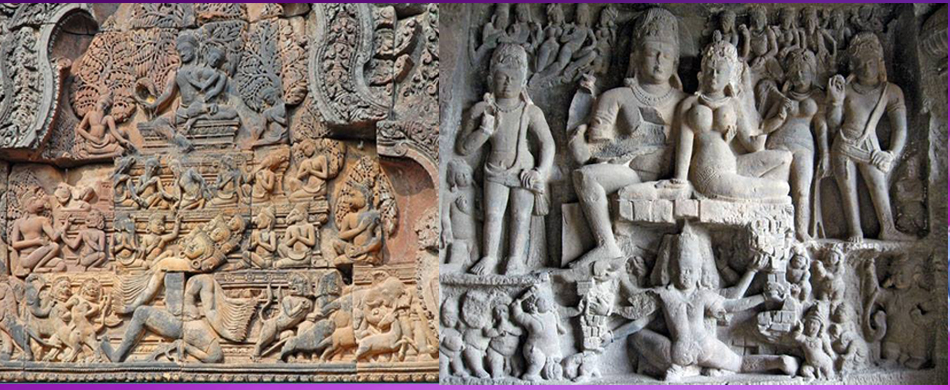
Shiva-Parvati—as husband and wife and a father and a mother—are the universal Hindu symbol for love, passion, and procreation. South and South-East Asian Hindu art depicts this couple very fondly. In the Kathmandu Valley, such images that can still be seen in the streets and temples are called Uma-Mahesvara.
Uma and Mahesvara, as a loving couple, are the prime source for creation. Hence, Uma (or Parvati) is seen in the prime of her youth, with full breasts and ample hips. She is often depicted topless, supposedly to attract Shiva, the masculine principle of creation. Shiva, too, is said to be virile among gods, and he is often seen naked with his erect male member exposed (ithyphallic).
Parvati, who acts as a motivator, feeds Shiva with energy, the reason for creation. Without Parvati, Shiva is nothing – he becomes Shava (corpse). Since a corpse can’t function, Shiva exists as long as Parvati permits him to exist. They act as masculine-feminine and positive-negative principles of creation; the union of the two makes the world fertile, organic, creative, and happy. 
The two pieces of sculpture of Shiva and Parvati that I like most come from Kailashnath temple in Ellora, India, and Banteay Srei in Cambodia. Below is the background for this particular theme.
When Sati committed suicide, Shiva felt utterly sad. Sati was his better half and he couldn’t live without her. He expressed his sorrow by carrying Sati’s lifeless body on his shoulder and roaming the earth for eons. After the tragic incident, Shiva finally married Parvati, who is essentially Sati’s incarnation. Reunited with his better half after many years of separation, Shiva was very happy. He spent many hours of the day simply being with her, holding her in his lap.
His fondness for Parvati is clearly shown as he holds her tightly in his lap, caressing her left breast with his hand. Imagine a cold afternoon on Mt. Kailash. The sun is shining and it must be a glorious moment to sunbathe in such cold Himalayan terrain. There the divine couple is sitting closely clasped together enjoying the warm sun when they are suddenly disturbed by a shake from beneath the mountain. Could this be an earthquake that so often strikes the Himalayan region?
According to legend, the mighty Ravana, king of Lanka (present-day Sri Lanka) prayed Shiva for a long time. Since Shiva didn’t show up in front of him as he often did, Ravana felt ignored and made a trip to Mt. Kailash to visit Shiva. For those who don’t know the story, Ravana was a great devotee of Shiva and it was Shiva from whom he got his power. The reason for ignoring Ravana was that Shiva was lost in Parvati’s arms; when a man (even a god) is smitten by a woman’s love, he forgets everything. Shiva was no exception.
Upon reaching Mt. Kailash, Ravana called Shiva from the foot of the mountain. Still, Shiva didn’t hear his cry. The angry Ravana, wishing to get Shiva’s attention, shook the massive Mt. Kailash with his hands. Of course, only Ravana could do such a thing, as Shiva blessed him with his super-power.
In these two stone reliefs, Ravana is depicted from behind as he shakes the mountain. For these Indian and Cambodian artists to portray the mythical scene in such sensitivity is beyond description. I salute the artists who spent months and even years carving the images of gods and goddesses in temples with no attachment of ego. They remain nameless.
 समष्टिगत विषयवस्तुको चित्रण ‘चियर्स’ कथासङ्ग्रह
समष्टिगत विषयवस्तुको चित्रण ‘चियर्स’ कथासङ्ग्रह
 वरिष्ठ अभिनेता कृष्ण मल्ल नेपाल फिल्म सोसाइटीको अध्यक्षमा निर्विरोध निर्वाचित
वरिष्ठ अभिनेता कृष्ण मल्ल नेपाल फिल्म सोसाइटीको अध्यक्षमा निर्विरोध निर्वाचित
 अनेसास कोलोराडो च्याप्टरको अध्यक्षमा किरण अधिकारी
अनेसास कोलोराडो च्याप्टरको अध्यक्षमा किरण अधिकारी
 सुनको मूल्य एकैदिन तोलामा २२ सयले घट्यो
सुनको मूल्य एकैदिन तोलामा २२ सयले घट्यो
 ‘पूर्णबहादुरको सारङ्गी’ बन्यो सबैभन्दा धेरै कमाउने चलचित्र, १४ दिनमा २७ करोड कमायो
‘पूर्णबहादुरको सारङ्गी’ बन्यो सबैभन्दा धेरै कमाउने चलचित्र, १४ दिनमा २७ करोड कमायो
 निर्देशक/कलाकार माओत्से गुरुङसँग “अग्निदहन” फिल्मलाई लिएर गरिएको छोटो कुराकानी
निर्देशक/कलाकार माओत्से गुरुङसँग “अग्निदहन” फिल्मलाई लिएर गरिएको छोटो कुराकानी
 अमेरिकाका नवनिर्वाचित राष्ट्रपति ट्रम्पद्वारा एलन मस्कलाई विशेष पदमा नियुक्त
अमेरिकाका नवनिर्वाचित राष्ट्रपति ट्रम्पद्वारा एलन मस्कलाई विशेष पदमा नियुक्त